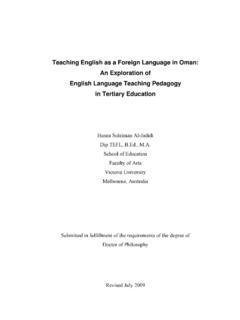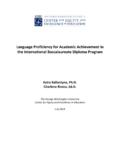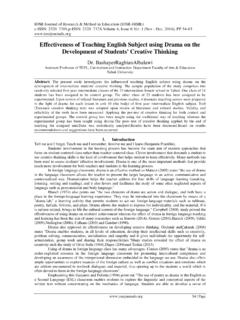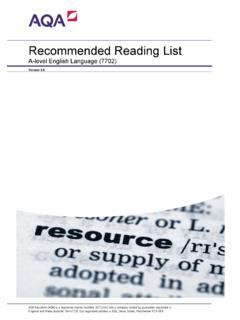Transcription of A Student Grammar - UTORweb
1 biblical hebrew A Student Grammar Ruth 1, the Aleppo Codex (10th c. ). John A. Cook Robert D. Holmstedt biblical hebrew : A Student Grammar (Draft Copy). 2009 by John A. Cook and Robert D. Holmstedt All rights reserved. Preface Purpose This textbook is intended for a university classroom. It is divided into thirty lessons, corresponding to the typical thirty-week academic year. Following the sequence of lessons will provide the average Student with a cutting-edge understanding of ancient hebrew Grammar and will enable the Student to read both prose passages and less complex poems from biblical and non- biblical texts. Additionally, the textbook introduces the Student to the standard biblical hebrew lexicon1 and includes an appendix on the Masoretic accents, which may be incorporated into the sequence of lessons at whatever point the instructor desires. Because of the variety of first-year biblical hebrew textbooks currently available, it is worth briefly noting what this textbook is not: it is not a reference Grammar ; it is not meant to be used without supplementation from the instructor; it is not meant for self-study; it is not theologically oriented.
2 What this textbook does not do represents fairly well the character of almost every other available textbook, and thereby indicates that there exists a significant lacuna in the world of hebrew textbooks. This textbook is intended to fill this hole. History The genesis of this introductory textbook for ancient hebrew lies in the experience of the two authors in teaching first-year biblical hebrew at the University of Wisconsin as graduate instructors, from 1996 to 2002. The desire for something different was born early in this period, after dissatisfaction with the out-datedness of Weingreen2 (which, in many ways, has yet to be surpassed in terms of pedagogy as a classroom textbook) and outright frustration with the lack of pedagogical awareness in Kelley,3 Seow,4 and Kittel,5 to name the most prominent textbooks then on the market. Necessity is the mother of invention, as the proverb goes, and, as in the case of most textbooks, eventually we decided that it was time to develop something different ourselves.
3 As we continued to teach hebrew after Wisconsin, we clarified the focus for our project and we identified two primary objectives: classroom pedagogy and a firm linguistic foundation. Design Objectives Our concern for classroom pedagogy is based on the simple observation that many of the textbooks on the market provide the Student with entirely too much information. We found ourselves instructing our students to skip entire sections in some of the textbooks we used. Not only is this frustrating for instructor and Student alike, it both establishes an underlying tension between the instructor and the textbook and creates a sense of distrust in the often expensive textbook the Student was required to purchase for the course. Clearly, we needed a textbook that 1. Brown, F., S. R. Driver, and C. A. Briggs. [1906] 1979. The New Brown-Driver-Briggs hebrew -English Lexicon. Peabody, MA: Hendrickson. 2. Weingreen, J. 1939. A Practical Grammar for Classical hebrew . Oxford: Oxford University.
4 [2nd edition, 1959 and 1967]. 3. Kelley, P. H. 1992. biblical hebrew : An Introductory Grammar . Grand Rapids, MI: Eerdmans. 4. Seow, 1987. A Grammar for biblical hebrew . Nashville, TN: Abingdon. [Revised edition, 1995]. 5. Kittel, B. P., V. Hoffer, and R. Abts Wright. 1989. biblical hebrew : A Text and Workbook. New Haven, CN.: Yale University. [Revised edition, 2005]. ii was created for the classroom and no more. In other words, we felt that the desire of many textbook authors to present, essentially, mini-reference grammars was an obstacle in the effective presentation of the material and quite often resulted in information overload. It is difficult to count the number of people who have recounted to us their experience of learning hebrew with anguish in their voices and a traumatic look in their eyes, and a little sensitive digging almost always turns up one overriding reason: poor pedagogy. To address the pedagogy issue we established an approach to each lesson that was based on three simple criteria: (1) what can we accomplish in the classroom in one week and still have fun?
5 (2). what must the students learn? and (3) what do the students not need to learn? The result was the thirty-lesson structure that moves the students quickly through the necessary but often less engaging introductory material to get to issues more salient for interpreting the ancient texts, such as clause structure and verbs. This enables us to introduce our students to stretches of biblical texts as early as the fourth week of the course. And since understanding texts is the motivation of the overwhelming majority of students in our courses, it only makes sense that this would both please them and reduce the dreaded mid-year attrition rate. It is important to note a critical feature of our textbook at this point: since it presents no more than is necessary, it does not itself introduce students to long stretches of hebrew discourse. Moreover, we do not introduce students to the features of either the Masoretic codices or the modern printed hebrew Bibles, including the critical apparatus of the Biblica Hebraica Stuttgartensia.
6 A number of Student -oriented introductions to these issues already exist and are likely in the nearest library; thus, we saw no good reason to reinvent the wheel, as it were. What this means is that the texts and the history of the hebrew Bible must be covered within the lesson planning external to the textbook. As with many modern language textbooks, even those with vibrant color and snazzy drawings or photographs, it is worth remembering that the textbook is a means to another end, not an end in and of itself. This explains why we eschew defining every language term we use (for example, pharyngeal ): it is the instructor's responsibility to have a basic competence in hebrew Grammar and grammatical terminology. Whenever it is necessary we do briefly define the linguistic terms we use ( , valency with regard to the binyanim, focus with regard to word order). For the items we do not define, we suggest using Gary Long's handbook,6 which can (and probably should) be used as a supplemental text.
7 Combining our textbook with Long's handbook achieves comprehensiveness without needlessly bloating the lessons. The second objective for our textbook is to build the lessons on a firm linguistic foundation. Both authors do research on the grammatical features of ancient ( biblical and non- biblical ). hebrew within explicitly linguistic frameworks, mostly typological and generative, and our conclusions have often been at odds with the consensus described in standard reference grammars and introductory textbooks (for example, you will find no reference in this textbook to the so-called waw-consecutive imperfect and perfect verbs, but instead will find the labels past- narrative and modal perfect, respectively). Hence, we desired a textbook that communicates our linguistically-grounded views to a first-year hebrew audience. While we try to avoid enmeshing 6. Long, G. A. 2002. Grammatical Concepts 101 for biblical hebrew : Learning biblical hebrew Grammatical Concepts through English Grammar .
8 Peabody, MA: Hendrickson. iii the first-year Student in the complexity of linguistics and typical linguistic description, we also take a high view of our audience's capacity to process basic linguistic concepts and to see how they apply to both hebrew and English. Finally, this textbook is what some might call traditional in its essential organization and presentation. Although each lesson does contain a diversity of categories for easier learning, the Student is moved through the linguistic categories of phonology, morphology, syntax, semantics, and pragmatics in mostly this order. With that said, we use more modern, or second language acquisition, teaching techniques in the classroom. Again, we did not write this textbook for every task of the language classroom. It is intentionally limited, and in light of this, we encourage instructors who use this textbook to plan accordingly: additional activities will be required for the first-year students to learn hebrew and, critically, for them to enjoy the process.
9 (For interested parties, we invite requests for sample syllabi and other teaching materials.). Note to the Reader: the glossary is currently undergoing revision; the glosses were initially based on a combination of information from the two primary hebrew -English lexica, BDB and HALOT. Additionally, a third set of glossing choices was motivated by simplicity and pedagogy rather than the often awkward English glosses given in either of the two lexica. Acknowledgments The detail and complexity of writing a introductory language textbook exceeded our wildest dreams. It is entirely possible that if we had not begun this project as ambitious, energetic doctoral students , we might never had begun it at all. Certainly, we are indebted to the eagle eyes of numerous instructors who followed us at UW and who willingly accepted the challenge of using a draft textbook. In particular, we are grateful to Michael Lyons, Kent Reynolds, James Kirk, and Tim Mackie for their numerous lists of typos and other infelicities.
10 Additionally, their queries helped us to formulate more clearly our design objectives. We are also indebted to Cynthia Miller, who endured the many drafts and yet remained willing to have the textbook used at UW. Finally, we are most recently thankful of the proofreading and general feedback that John Hobbins (Madison), Laliv Clenman (Toronto), and Brauna Doidge (Toronto) have provided. John A. Cook Robert D. Holmstedt Wilmore, KY Toronto, ON. June 18, 2009. iv Table of Contents Lesson The biblical hebrew Alphabet Vocabulary #1. Exercises Lesson The biblical hebrew Vowel System Simple Sheva . Compound Sheva Independent Personal Pronouns Verbless Clauses Dagesh Qal and Dagesh Chazaq Guttural Consonants Open and Closed Syllables and Word Stress Vocabulary #2. Exercises Lesson Grammatical Words versus Lexical Words Definiteness Definiteness in biblical hebrew The Article . Inseparable Prepositions ( , , , and sometimes ) . Vav Conjunction (- ) . Vocabulary #3. Exercises Lesson Masculine and Feminine Singular Nouns Introduction to Verbs Qal Perfect Conjugation - Singular Objects in biblical hebrew Vocabulary #4.








